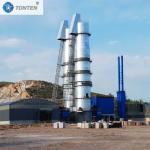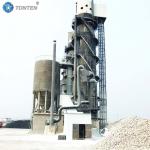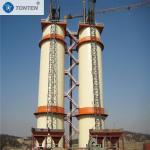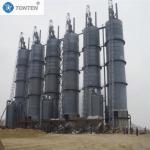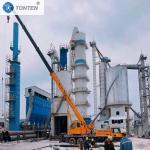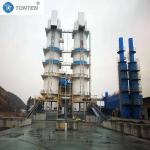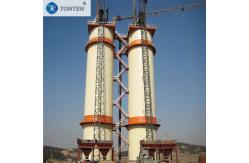Vertical Shaft Kiln Active Lime Plant Lime Kiln Production Line
Working principle:
The vertical kiln is a cylindrical equipment with an all-steel
structure. The materials are added from the top of the kiln and
discharged from the bottom of the kiln after calcination. Lime is
burned by using the principle of heat exchange between the downward
movement of the materials and the rising heat of the hot air.
According to the temperature change and distribution in the
vertical kiln, the vertical kiln is divided into three areas from
top to bottom: preheating zone, calcining zone, and cooling zone;
in the preheating zone, the materials are preheated with the heat
of the flue gas; in the calcining zone, the materials are calcined
with the heat released by the combustion of the fuel; in the
cooling zone, the calcined materials exchange heat with the blown
cold air, the materials themselves are cooled, and the air is
heated and enters the calcining zone as combustion air. In order to
ensure that each section of the material calcination process is
fully and completely carried out, the three zones in the vertical
kiln should maintain a certain height and strive to be stable.
There are two reasons for the movement of materials in the vertical
kiln: one is the movement of the upper material due to the volume
contraction of the material during the calcination process; the
other is the movement of the whole kiln material due to the
discharge of the lower material. During the descent process, the
material undergoes a complex heat exchange with the hot coal gas,
accompanied by the decomposition of limestone and the growth of
quicklime grains. When the whole process is completed, it is also
cooled by the combustion air to a temperature 60°C higher than the
ambient temperature. Then, the lime is unloaded onto the belt
conveyor outside the furnace by the disc ash discharger and the
two-stage sealing valve without leaking the combustion air. It has
stable and reliable operation, environmental protection and energy
saving, and a high degree of automation. It can use various low
calorific value converters, blast furnace gas, calcium carbide
furnace tail gas, etc. as fuel. The cooling air carrying heat
enters the calcining zone to participate in combustion, thereby
reducing energy consumption; the remaining hot flue gas after the
fuel combustion releases heat to calcine material enters the
preheating zone to preheat the material at room temperature to
pre-decomposition temperature.
Specification:
Lime activity /ml | 220~280(depending on the composition of limestone) |
Ash discharge temperature /℃ | Ambient temperature +60 |
Limestone kiln particle size /mm | 30~80/80~120 |
Emission concentration /(mg/Nm3) | ≤30 |
Number of working days per year / day | ≥340 |
Capacity | 150ton per day |
Number of operators/(person/shift) | 2 |
Applicable fuel | Lump anthracite, lump coke, lump petroleum coke, etc. |
